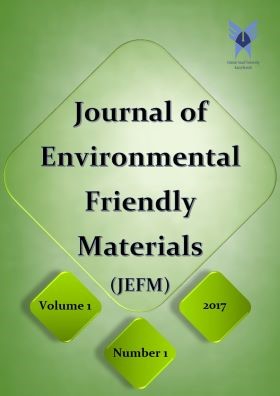Produce of Biodegradable Porous Mg-Zn Scaffold via Powder Metallurgy and Coated with Nano HAP Synthesized by Electrodeposition Process
محورهای موضوعی : Journal of Environmental Friendly MaterialsZ.S. Seyedraoufi 1 , Sh. Mirdamadi 2
1 - School of Metallurgy and Materials Engineering, Iran University of Science and Technology, Tehran, Iran.
2 - School of Metallurgy and Materials Engineering, Iran University of Science and Technology, Tehran, Iran.
کلید واژه:
چکیده مقاله :
Mg is considered promising degradable material for tissue engineering applications because of good biocompatibility, corrosion and mechanical properties. In the present work, biodegradable porous Mg-1 wt% Zn scaffold was produced by powder metallurgical process and then nano hydroxyapatite (HAP) coating with composition of Ca10(PO4)6(OH)2 on the scaffold was synthesized by pulse electrodeposition and alkali treatment processes to increase the corrosion resistance of the substrate. The results showed that the as-deposited coating consists of HAP, CaHPO4.2H2O (DCPD) and Ca8H2(PO4)6.5H2O (OCP) with plate-like and needle-like morphologies and the post-treated coating was composed of needle-like structure of nano HAP developed almost perpendicularly to the substrate .Electrochemical tests indicated that the corrosion current density reduced from2.731×10-3 to 4.98×10-5 A.cm-2 and the corrosion potential of scaffold increased from -1.451 to -1.37 V. This study revealed that electrodeposition of HA coating is a useful approach to improve the corrosion resistance of porous Mg-Zn scaffold in SBF and to develop Mg-based degradable implants.
[1] C.H. Chang, F.H. Lin, T.F. Kuo and H.C. Liu, J. Biomed. Eng. Appl. Basis and Comun, 17(2005), 1.
[2] M.V. Risbud, M. Sittinger, J. Trends in Biotech. , 20(2000), 351.
[3] J. Bonadio, E. Smiley, P. Patil and S. Goldstein, J. Nat. Med., 5(1999), 753.
[4] H.Y. Cheung, K.T. Lau, T.P. Lu and D. Hui, J. Composites Part B., 38(2007), 29.
[5] A.H. Yusop, A.A. Bakir, N.A. Shaharom, M.R. Abdul Kadir and H. Hermawan , Int. J. Biomaterials , 1(2012), 1.
[6] N.E.L. Saris, E. Mervaala, H. Karppanen, J.A. Khawaja and A. Lewenstam , J. Clinica. Chemica. ACTA, 294(2000), 1.
[7] J. Vormann, J. Mol. Aspects Med., 24(2003), 27.
[8] T. Okuma, J. Nutr. , 17(2001), 679.
[9] M.P. Staiger, A.M. Pietak, J. Huadmai and G. Dias, J. Biomaterials, 27(2006), 1728.
[10] F. Witte, V. Kaes, H. Haferkamp, E. Switzer, A. Meyer-Lindenberg, C. Wirth and H. Windhagen , J. Biomaterials , 26(2005) , 3557.
[11] Z.J. Li, X.N. Gu, S.Q. Lou and Y.F. Zheng, J. Biomaterials, 29(2008), 1329.
[12] G.L. Song, J. Corros. Sci., 49(2007), 1696.
[13] S. Gonzáleza, E. Pellicera, J. Fornella and A. Blanquer, J. Mech. behave. Bio-med. mater., 6(2012), 53.
[14] Kh. Abdelrazek Khalil, Int. J. Electrochem. Sci., 7(2012), 10698.
[15] C.J. Deng, M.L. Wong, M.W. Ho, P. Yu and H.L. Dickon , J. Composites Part A , 36(2005) , 551.
[16] X. Gu, Y. Zheng, S. Zhong and T. Xi, J. Biomaterials, 31(2010), 1093.
[17] A. Kaya, D. Eliezer, G. Ben-Hamu, O. Golan, Y.G. Na and K.S. Shin, J. Met. Sci. Heat Treat. , 48(2006), 50.
[18] E. Zhang, D. Yin, L. Xu, L. Yang and K. Yang, Mater. Sci. Eng. C, 29(2009), 987.
[19] H. Wang, S. Guan, X. Wang, C. Ren and L.Wang, Acta Biomaterialia, 6(2010), 1743.
[20] M. Saremi, B. Motaghi Golshan, Iranian J. Mater. Sci. Eng., 3(2006), 1.
[21] Y. Song, D. Shan and E. Han, Mater. Lett., 62(2008), 3276.
[22] W. Li, S. Guan, J. Chen, J. Hu, S. Chen, L. Wang and S. Zhu, Mater. Charac., 62(2011), 1158.
[23] Z. Chun-Yan, Z. Rong-Chang, L. Cheng-Long and G. Jia-Cheng, Surf. Coat. Technol., 204(2010), 3636.
[24] E. Meng, S. Guan, H. Wang, L. Wang, S. Zhu, J. Hu, C. Ren, J. Gao and Y. Feng, Appl. Sur. Sci., 257(2011), 4811.
[25] T. Kokubo, H. Takadama, J. Biomaterials, 27(2006), 2907.
[26] H. Zhuang, Y. Han and A. Feng, Mater. Sci. Eng. C, 28(2008), 1462.
[27] M.B. Kannan, R. Raman, J. Biomaterials, 29 (2008), 2306.


